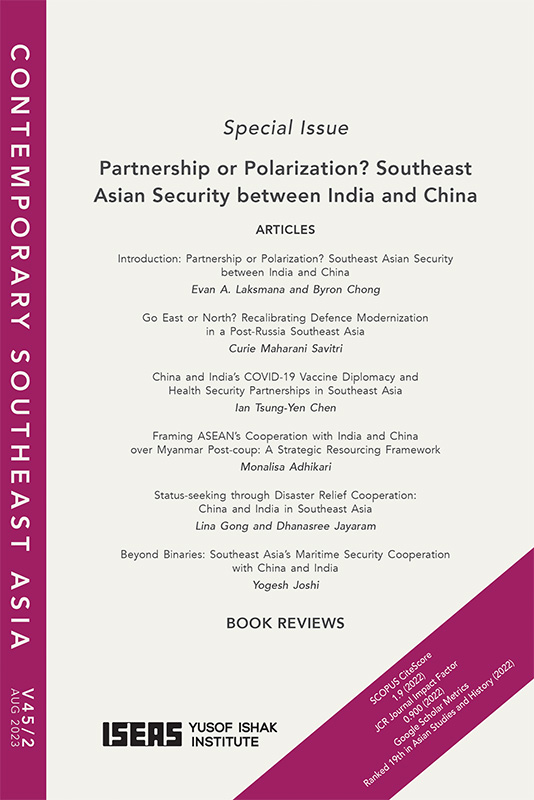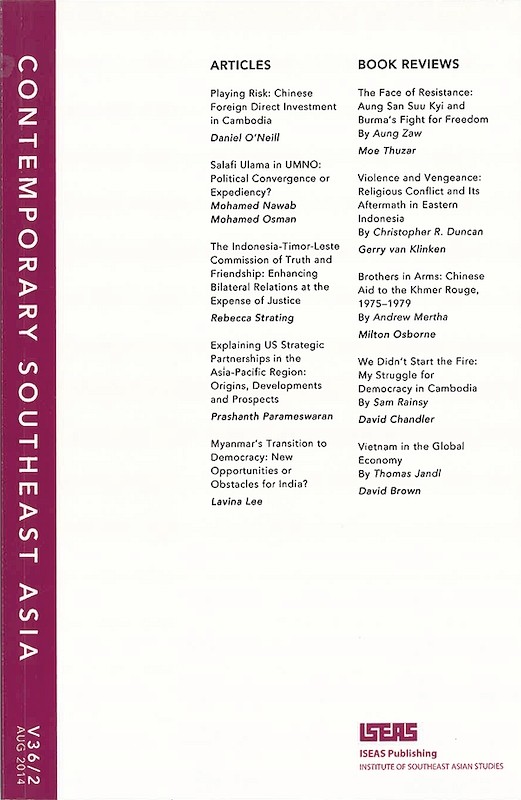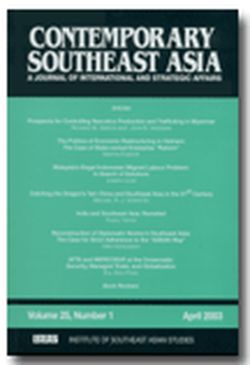Contemporary Southeast Asia Vol. 45/2 (August 2023)

Date of publication:
August 2023
Publisher:
ISEAS – Yusof Ishak Institute
Number of pages:
189
Code:
CS45/2
Soft Cover
ISSN: 0129797X
Contents
-
Contemporary Southeast Asia Vol. 45/2 (August 2023)
[Whole Publication, ISSN: 1793284X] -
Preliminary pages
- ARTICLES
-
1. Introduction: Partnership or Polarization? Southeast Asian Security between India and China, by Evan A. Laksmana, Byron Chong, authors see abstractSoutheast Asian states face numerous security challenges that require the assistance of external partners. China and India, two Indo-Pacific powerhouses, could offer potential solutions but their relations with Southeast Asian states vary considerably. At the same time, escalating tensions between China and India increase the risks of their engagement with Southeast Asian states leading to greater polarization in the region. By utilizing the “4-C Calculus”, which comprises cost, complexity, credibility and capacity, this special issue seeks to understand how Southeast Asian states evaluate China and India as potential security cooperation partners, and whether cooperation with both—together or individually—can help address the region’s security needs. The articles in this special issue employ the 4-C framework to analyse five key security concerns: defence modernization; health security; the postcoup crisis in Myanmar; humanitarian assistance and disaster relief; and maritime security. They contribute to the literature on security partnerships by providing fresh insights into our understanding of why and how smaller states partner with larger powers over shared security challenges, as well as by illustrating how certain policy considerations can influence the direction and quality of security partnerships.
-
2. Go East or North? Recalibrating Defence Modernization in a Post-Russia Southeast Asia, by Curie Maharani Savitri, author see abstractSoutheast Asian countries implementing defence modernization programmes generally seek to create a diversity of foreign arms suppliers to avoid over reliance on a single provider. Due to Russia’s decline as a key arms supplier following its invasion of Ukraine in February 2022, regional countries are adjusting their procurement strategies by looking for new partners such as India and China. This article has two objectives: to analyse the patterns of arms procurement diversification across seven Southeast Asian nations—Singapore, Indonesia, Thailand, the Philippines, Vietnam, Malaysia and Myanmar—and to identify the factors driving diversification, focusing on the cost, complexity, capability and credibility (4Cs) of the arms suppliers. The same 4Cs framework is also employed to evaluate the likelihood of India and China becoming partners in three procurement areas: arms maintenance, emerging technology and the sale of significant conventional arms of Russian origin. The article concludes that India has the potential to be a partner for maintenance, while China could be a partner for emerging technology and major conventional arms which do not depend on critical foreign technologies.
-
3. China and India’s COVID-19 Vaccine Diplomacy and Health Security Partnerships in Southeast Asia, by Ian Tsung-Yen Chen, author see abstractBy analysing three case studies—Singapore, Cambodia and Myanmar—this article investigates health security partnerships formed by Southeast Asian countries during the COVID-19 pandemic, focusing on their responses to China and India’s vaccine diplomacy. It argues that a combination of factors—the capability of national governments in responding to the pandemic and the cost of doing so, as well as the credibility of vaccines and geopolitical relationships with potential partners—led to a divergence in partnerships. Singapore did not rely on Chinese vaccine donations but its acceptance of assistance from China was a diplomatic move to maintain a balanced policy amidst the United States-China strategic rivalry. In contrast, Cambodia and Myanmar were obliged to partner with either China or India due to their limited capacity to manage the crisis as well as their lack of financial resources and access to top-tier vaccines. Geopolitics also played a role. China became a leading partner for Cambodia due to the strong strategic relationship they had formed before the pandemic, while the governments of Myanmar—before and after the military coup in February 2021—based their partnerships on varying political and geopolitical considerations.
-
4. Framing ASEAN’s Cooperation with India and China over Myanmar Post-coup: A Strategic Resourcing Framework, by Monalisa Adhikari, author see abstractThe ASEAN-led Five-Point Consensus (5PC) framework calls for an immediate end to violence, dialogue among all parties and the provision of humanitarian assistance to address the post-coup political crisis in Myanmar. Such endeavours have yet to deliver concrete outcomes. However, this article argues that there is an opportunity for ASEAN to work with India and China through a framework of “strategic resourcing” to break the impasse. Strategic resourcing does not seek to foster a trilateral framework between ASEAN, India and China but seeks to take advantage of the comparative strengths of the two states across two thematic domains, both of which are critical for the implementation of the 5PC: (1) using Indian and Chinese borderlands to establish humanitarian corridors to deliver aid, and (2) using the economic, political and normative leverage that India and China possess over different political constituencies in Myanmar to bring an immediate end to the violence and to foster dialogue for a long-term solution. This article explores the prospects of that process as well as the institutional mechanisms that ASEAN could wield to cooperate with India and China through the strategic resourcing framework. It also explains some of the framework’s limitations. Conceptually, “strategic resourcing” adds to and differentiates from the dominant framework of “hedging”, which has been mooted as an explanation for ASEAN’s international security cooperation. Practically, the article charts policy options to strengthen and reform the current 5PC format, notably on the framework of the proposed dialogue process.
-
5. Status-seeking through Disaster Relief Cooperation: China and India in Southeast Asia, by Lina Gong, Dhanasree Jayaram, authors see abstractThis article examines China and India’s status-seeking efforts in Southeast Asia through the lens of disaster relief cooperation. It explores status-seeking processes and the region’s responses, as well as how these shape the regional security order in the Asia-Pacific. We argue that the outcomes of China and India’s status-seeking are determined by their own behaviours and the region’s interpretations of them. Our analysis reveals that China seeks to elevate its status to become a leading security partner of Southeast Asia, which has only been partially accepted by the region, as demonstrated by its active and institutionalized cooperation with ASEAN but its haphazard bilateral HADR engagement with individual Southeast Asian countries. Meanwhile, India has gone from a low-key player to an important partner, primarily in military terms, as shown by its membership in regional multilateral institutions, the holding of regular bilateral exercises and an acceptance by Southeast Asian states of the deployment of its military for HADR missions.
-
6. Beyond Binaries: Southeast Asia’s Maritime Security Cooperation with China and India, by Yogesh Joshi, author see abstractThis article explores the current and future dynamics of Southeast Asia’s maritime cooperation with China and India. Southeast Asian states do not only have diverse agendas when it comes to non-traditional and traditional maritime security issues, but their prioritization of these threats also vary. Those variations primarily define Southeast Asian interests for partnerships with actors such as India and China. Given China’s geographical centrality, its strong economic relationship with countries in the region and the proximity of its military power, Southeast Asia states will remain far more invested in maritime security cooperation with China than India. Yet, China’s territorial and maritime jurisdictional disputes in the South China Sea, and its overpowering shadow on the region, have contributed to anxiety among Southeast Asian states and their search for other security partners. The evolving threat of China’s rise and polarization within the region gives New Delhi opportunities to engage. India-China rivalry is also a significant motivation for New Delhi to engage in Southeast Asia’s maritime security. Two avenues for this include naval arms transfers and training for sea denial missions to claimant countries in the South China Sea, and cooperation in Maritime Domain Awareness (MDA) against illegal, unreported and unregulated (IUU) fishing.
- BOOK REVIEWS
-
BOOK REVIEW: A Brief History of Vietnam: Colonialism, War and Renewal: The Story of a Nation Transformed, by Bill Hayton, by Vu Minh Hoang, author
-
BOOK REVIEW: China’s Asymmetric Statecraft: Alignments, Competitors, and Regional Diplomacy, by Yuxing Huang, by Chong Ja Ian, author
-
BOOK REVIEW: Crafting Parliament in Myanmar’s Disciplined Democracy (2011-2021), by Renaud Egreteau, by Jacques Bertrand, author
-
BOOK REVIEW: Pukul Habis: Total Wipeout: A Story of War in Malaysia and Singapore, by David Boey, by Tim Huxley, author
-
BOOK REVIEW: Hatta and Indonesia’s Independent and Active Foreign Policy: Retrospect and Prospect, edited by Evan A. Laksmana and Lina Alexandra, by Deasy Simandjuntak, author
-
BOOK REVIEW: Middle Powers in Asia Pacific Multilateralism: A Differential Framework, by Sarah Teo, by Shaun Narine, author





